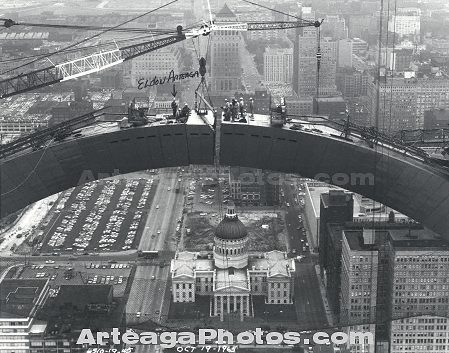Each leg of the arch is an equilateral triangle with sides 54 ft. long at ground level, tapering to 17 ft. at the top. The legs have double walls of steel 3 ft. apart at ground level and 7-3/4 in. apart above the 400-foot level. Up to the 300-foot mark the space between the walls is filled with reinforced concrete. Beyond that point steel stiffeners are used. The double-walled, triangular sections were placed one on top of another and then welded inside and out to build the legs of the Arch. Sections ranged in height from 12 ft. at the base to 8 ft. for the two keystone sections.
The complex engineering design and construction is completely hidden from view. All that can be seen is its sparkling stainless steel outside skin and inner skin of carbon steel, which combine to carry the gravity and wind loads to the ground. The Arch has no real structural skeleton. Its inner and outer steel skins, joined to form a composite structure, give it its strength and permanence.
Reinforced concrete foundations sunk 60 ft. into the ground and extend 30 ft. into the bedrock and contribute substantially to the strength of the Arch. Structural engineers designed the Arch only to deflect at the top 18 in. in the east-west direction, because its legs are oriented on a north-south line. Alloy-steel tensioning bars or tendons, 252 of them for each leg, extend 34 ft. below the top of the foundations to anchor the structure securely to its base. When the keystone sections were placed, a crown thrust was applied by hydraulic jacks to increase the comprehessive bending stress in the Arch legs to offset tensile stress under wind load. The extra steel in the upper region of the Arch resists additional axial and bending stresses due to the increased crown thrust.
Above the foundation, concrete in the walls of the Arch were prestressed up to a heght of 300 ft. Above this level the space between hte inner and outer walls is hollow and steel bracing joins the inner and outer skins. This design reduces sway because the bulk of the weight is in the concrete-filled lower sections of the Arch. 
|
